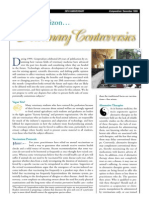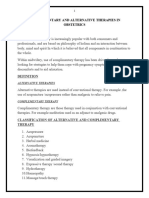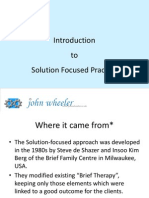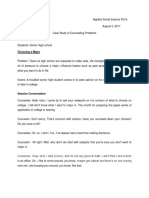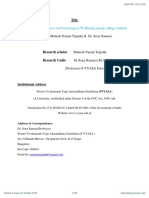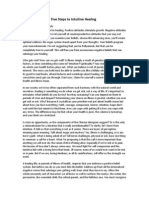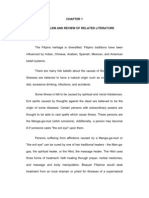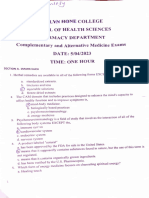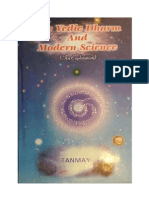Prayer Therapy
Prayer Therapy
Uploaded by
mit-mitCopyright:
Available Formats
Prayer Therapy
Prayer Therapy
Uploaded by
mit-mitCopyright
Available Formats
Share this document
Did you find this document useful?
Is this content inappropriate?
Copyright:
Available Formats
Prayer Therapy
Prayer Therapy
Uploaded by
mit-mitCopyright:
Available Formats
APRIL 2009
DELHI PSYCHIATRY JOURNAL Vol. 12 No.1
Review Article
Prayer Therapy
Maryam Safara, M.S. Bhatia Department of Psychiatry, UCMS & GTB Hospital, Dilshad Garden, Delhi-110095, University of Delhi
Introduction Prayer is any personal, impersonal or transpersonal way to express communion with the sacred. Prayer is a universal religious phenomenon because it stems from the natural human disposition to give expression to thought and emotion. As man naturally communicates by speech with his fellows, he instinctively addresses the supernatural powers of his belief through the same medium. Prayer is a natural and necessary outcome of belief in God. To stress this point one can quote some important personalities. For instance, Luther says very emphatically that faith is, Prayer and nothing but prayer, and continues, He who does not pray or call upon God in his hour of need, surely does not think of Him as God, not does he gives Him the honor that is His due. Prayer is a way offered by the Holy Spirit to reach God. It is not merely a question or an entreaty. It cannot succeed until you realise that it asks for nothing. How else could it serve its purpose? It is impossible to pray for idols and hope to reach God. True prayer must avoid the pitfall of asking to entreat. Prayer has no beginning and no end. It is a part of life. But it does change in form, and grow with learning until it reaches its formless state, and fuses into total communication with God. In its asking form it need not, and often does not, make appeal to God, or even involve belief in Him. At these levels prayer is merely wanting, out of a sense of scarcity. Prayer is a way to true humility. And here again it rises slowly up, and grows in strength and love and holiness. Let it but leave the ground where it begins to rise to God, and true humility will come at last to grace the mind that thought it was alone and stood against the world. Humility
brings peace because it does not claim that you must rule the universe, nor judge all things as you would have them be. All little gods it gladly lays aside, not in resentment, but in honesty and recognition that they do not serve. Prayer therapy is still not widely accepted among medical professionals, many of whom feel the positive study results are caused by placebo effects, or that the patients may pray for themselves or have family members pray for them, which would compromise the results of the control (nonprayed for) groups. However, several studies 114 have proven these explanations to be false. Since 1988, almost 200 other tightly controlled studies have reached results that also strongly confirm the power of prayer on a wide variety of subjects, including patients with AIDS, heart, cancer and Alzheimers disease and even in one study in which women at a fertilization clinic had higher pregnancy rates when total strangers were praying for them. Prayer may be silent or spoken out loud and can be done alone in any setting or in groups (as in a church, temple, or mosque). Regular attendance at a church, temple, or mosque may involve prayer that focuses on you or on others. Sometimes, the entire congregation of a church may be asked to pray for a sick person or the persons family. Some religions set aside certain times of the day and special days of the week for praying. Standard prayers are often memorized and repeated during private sessions and in groups. Prayer can also be done individually and in informal groups, without a specific religion or denomination, with no particular schedule. Prayers often ask a higher power for help, understanding, wisdom, or strength in dealing with lifes problems. The benefits of praying may include:
67
Delhi Psychiatry Journal 2009; 12:(1) Delhi Psychiatric Society
DELHI PSYCHIATRY JOURNAL Vol. 12 No.1
APRIL 2009
reducing stress and anxiety1,10 promoting a more positive outlook and a stronger will to live Prayer have the ability to move the imagination into a meditative space. prayer, can alter our perceptions, deepen our appreciation of the commonplace, and collapse the distance between everyday life and a more numinous experience. Prayer, is a deeply imaginal experience that opens us to mystery, to the ineffable by allowing us a deeper felt sense of the created world. Examining the effects of prayer upon health outcomes has been controversial, the authors acknowledge. However, carefully examining the role of the human spirit in healthcare does not diminish its mystery, but it separates the mystery from the question of utility in healthcare practice, Krucoff said.15 William Stewart,16 said there was a growing body of scientific work suggesting that prayer does have a beneficial healing effect. Most people who have a cancer diagnosis now engage in some sort of social support activity, he said. If we look at prayer as a support network, it could contribute to the well-being and healing of an individual. John Arndt,14 a great mystic says, Our end is to seek, find and ultimately be one with God, and prayer is the means to achieve that end. Richard Rothe17 too stresses the same point when he says that the religions impulse is essentially the impulse to pray therefore the non-praying man is rightly considered to be religiously dead. Gill9 quotes in his essay what white singer told him about prayer, Prayer is not like you and me, its like a holy person. It has a personality five times that ours. No one can sincerely practice a faith, certainly not the Jewish, Christian, or Muslim faith, for its health benefits. Theists engage in prayer because that is where they encounter God. The central, crucial thing about prayer is that it is a way of entering into a personal relation with the creator and sustainer of life. In prayer, humans come before God as creatures acknowledging a difference in kind between themselves and God. They come not simply to a more powerful person who has what they need, as they might come before a judge or a parole board, but before the One who is the source and the end of their existence. They come to God, whose perfect knowledge and love precede their petitions and make them possible. Certainly they
68
present themselves as needy, but they do not come solely to get their needs met, at least in the sense of a list of petitions and intercessions for which they pray. They come to meet their most fundamental need as theists perceive thisthe need for God. The studies through history have evidenced that praying and benedictions have truly been considered in the world of human beings. In the holy Quran, mental health has deeply been emphasized and about 6236 verses are talking about the efficient human training. Praying (benediction) means the statement of needs and requests towards the source of knowledge and authority and showing courtesy towards divinity. God says, call me then I will accept what you say a. Praying could be a way for calling God for help. The Prophet told a needy person would you like me to inform you of whatever stops your pain even if it is a poison? He answered yes then the prophet answered : Praying. Also Imam Ali (A.S.) has mentional that praying is the key factor of success and is a way of salvation; he added that the best praying is the one which originated from a purified heart. Today psychologists have found that praying and faith would decrease stress, disappointment and fear. The Holy Quran in Rad , verse 28, say be aware!All the hearts never remain safe except with the name of God. Some commentators argue on the basis of those studies of prayer with positive results that health care professionals ought to engage in discussions of prayer with their patients and encourage them in its practice. Others venture even further, maintaining that such studies indicate that physicians and nurses should initiate prayers with their patients at the bedside. If a study seemed to show that intercessory prayer did not produce the expected beneficial medical effects, this would not clearly display that it had been inefficacious. Proponents of testing prayer could argue that it had not been carried out with the appropriate intensity, uttered by persons of sincere faith, or pursued by sufficient numbers of people. If, on the other hand, a study seemed to show that prayer had produced therapeutic results, this would not necessarily demonstrate that it was prayer that had brought about these results. Opponents of testing prayer could claim that they were accidental and that the study had not been
Delhi Psychiatry Journal 2009; 12:(1) Delhi Psychiatric Society
APRIL 2009
DELHI PSYCHIATRY JOURNAL Vol. 12 No.1
conducted on a welldefined set of patient behaviors, controlled adequately for confounding variables, or pursued with sufficient numbers of people. Thus results demonstrating either the failure or success of prayer could be dismissed as having omitted certain significant empirical factorsand there would always be more of these to consider. In fact, a national survey conducted by the National Center for Complementary and Alternative Medicine at the National Institutes of Health found that 43% of Americans prayed for their own health and 24% reported that others were praying for them. Nevertheless, in the one of the most scientifically rigorous studies ever conducted on prayer therapy, findings show that prayers by congregations located far away from patients hospitalized for heart procedures did not reduce the rate of major complications or death. Review of Literature Recent studies provide some support for the idea that prayer has curative powers. From the standpoint of modern scientific medicine, no treatment should be employed without evidence of its effectiveness and safety. Therefore, it is not surprising that some scientists are attempting to test the efficacy of prayer as a form of therapy. In a recent study,16 physicians at St. Lukes Hospital in Kansas City, Missouri, found that patients admitted to a coronary care unit who were prayed for without their knowledge for four weeks suffered about 10 percent fewer complications than those who had no one assigned to pray for them. 748 patients undergoing percutaneous coronary intervention or elective catheterisation in nine USA centres wer e assigned in a 2 2 factorial randomisation either off-site prayer by established congregations of various religions or no off-site prayer (double-blinded) and MIT therapy or none (unmasked). The primary endpoint was combined in-hospital major adverse cardiovascular events and 6-month readmission or death. Prespecified secondary endpoints were 6-month major adverse cardiovascular events, 6 month death or readmission, and 6-month mortality. 371 patients were assigned prayer and 377 no prayer; 374 were assigned MIT therapy and 374 no MIT therapy. The factorial distribution was: standard care only, 192; prayer only, 182; MIT therapy only, 185; and both
prayer and MIT therapy, 189. No significant difference was found for the primary composite endpoint in any treatment comparison. Mortality at 6 months was lower with MIT therapy than with no MIT therapy (hazard ratio 035 (95% CI 015 082, p=0016). Neither masked prayer nor MIT therapy significantly improved clinical outcome after elective catheterisation or percutaneous coronary intervention. Krucoff et al 15 investigated the effects of noetic therapies on heart patients undergoing treatment to unclog their coronary arteries. Noetic therapies are treatments that dont involve drugs, surgery, or other tangible intervention. The therapy receiving the most attention were prayers delivered remotely by people unknown to the patients. in the pilot study, 30 patients undergoing conventional ther apy to unblock their coronary arteries unknowingly received prayers from people they did not know. A variety of clinical results from these patients were then compared with those of 30 patients who received conventional care, but no prayer therapy. While no patient in the conventional care group died, one patient in the prayed-for group died during the six-month study period. In addition, no patient in either group suffered congestive heart failure. In the group randomly assigned to prayer therapy, there was a 50 percent reduction in all complications and a 100 percent reduction in major complications. Byrd3 in a randomized, controlled study, he separated patients who had suffered heart attacks into two groups: those who received standard medical care and those who were prayed for by three to seven born-again Christians. No onenot patients, staff, or Byrdknew who was being prayed for and who wasnt. Byrd found that patients who were the subjects of prayer did better than those who were not. They needed fewer antibiotics, experienced a lower percentage of congestive heart failure, and were less likely to develop pneumonia. He concluded thatintercessory prayer to a JudeoChristian God has a beneficial effect in patients admitted to a coronary care unit. William et al 16 determine the Effects of Remote, Intercessory Prayer on Outcomes in Patients Admitted to the Coronary Care Unit. Nine hundred ninety consecutive patients who were newly admitted to the coronary care unit (CCU).
69
Delhi Psychiatry Journal 2009; 12:(1) Delhi Psychiatric Society
DELHI PSYCHIATRY JOURNAL Vol. 12 No.1
APRIL 2009
At the time of admission, patients were randomized toreceive remote, intercessory prayer (prayer group) or not (usual care group). The first names of patients in the prayer group were given to a team of outside intercessors who prayed for them daily for 4 weeks. Patients were unaware that they were being prayed for, and the intercessors did not know and never met the patients. Compared with the usual care group (n = 524), the prayer group (n = 466) had lower mean SEM weighted (6.35 0.26 vs 7.13 0.27; P=.04) and unweighted (2.7 0.1 vs 3.0 0.1; p =.04) CCU course scores. Lengths of CCU and hospital stays were not different. Remote, intercessory prayer was associated with lower CCU course scores. This result suggests that prayer may be an effective adjunct to standard medical care. OLaoire18 examined the effects of intercessory prayer on self-esteem, anxiety, and depression in 406 subjects (who received either no prayer, directed prayer, or nondirected prayer) and in the 90 intercessors. There were no specific benefits detected for the prayer groups. A pilot study19 of the effects of intercessory prayer on 40 recovering alcoholics likewise reported no clinical benefit. Walker et al19 examined the intercessory prayer in the treatment of alcohol abuse and dependence on 496 patients. those who prayed (agents, n = 90) and those who were prayed for (subjects, n = 406). Agents were randomly assigned to either a directed or nondirected prayer group; photos and names of subjects were used as a focus. Subjects were randomly assigned to three groups: those prayed for by nondirected agents, a control group, and those prayed for by directed agents. Prayer was offered for 15 minutes daily for 12 weeks. Each subject was prayed for by three agents. Subjects improved significantly on all 11 measures. Agents improved significantly on 10 measures. A significant positive correlation was found between the amount of prayer the agents did and their scores on the five objective tests. Agents had significantly better scores than did subjects on all objective measures. Subjects views of the locus of Gods action showed significance in three objective measures. Improvement on four objective measures was significantly related to subjects belief in the power of prayer for others. Improvement on all 11 measures was significantly related to subjects conviction concerning whether
70
they had been assigned to a control or an experimental group. Sicher et al20 conducted a pilot study of the effect of intercessory prayer on patients entering treatment for alcohol abuse or dependence. In addition to standard treatment, 40 patients admitted to a public substance abuse treatment facility for treatment of alcohol problems who consented to participate were randomized to receive or not receive intercessory prayer (doubleblind) by outside volunteers. Assessments were conducted at baseline, 3 months, and 6 months. No differences were found between prayer intervention and nonintervention groups on alcohol consumption. Compared with a normative group of patients treated at the same facility participants in the prayer study experienced a delay in drinking reduction. Those who reported at baseline that a family member or friend was already praying for them were found to be drinking significantly more at 6 months than were those who reported being unaware of anyone praying for them. Greater frequency of prayer by the par ticipants themselves was associated with less drinking, but only at months 2 and 3. Intercessory prayer did not demonstrate clinical benefit in the treatment of alcohol abuse and dependence under these study conditions. Prayer may be a complex phenomenon with many interacting variables. One study evaluated the effect of distant prayer on patients with advanced AIDS because so many people with HIV said they were relying on spiritual healers and getting benefits from prayer. Twenty of the 40 patients were prayed forsix days a week for ten weeksby experienced healers from Christian, Jewish, Buddhist, Native American, shamanic, and other traditions. The healers had photos of the patients and knew their first names, CD4+ counts, and symptoms. A rotating healing schedule randomized healers to patients on a weekly basis to minimize possible differences in healer effectiveness. The study employed a pair-matched design to control for age, higher T cell count, and illness history. After six months, the investigators found that the prayedfor patients had significantly fewer new AIDS-defining illnesses (2 vs. 12), saw their doctors less often (185 vs. 260 visits), and spent fewer days in the hospital (10 vs. 68 days). They also showed marked improvement in mood.
Delhi Psychiatry Journal 2009; 12:(1) Delhi Psychiatric Society
APRIL 2009
DELHI PSYCHIATRY JOURNAL Vol. 12 No.1
Byrd3 led the way for investigators intent upon learning whether distant prayer can help heal with his 1988 study of 393 patients in San Francisco General Hospitals CCU, half of whom were prayed for by a group of born-again Christians. Byrd found that the prayed-for patients were less prone to congestive heart failure and cardiac arrest and fewer of them needed diuretics and antibiotics than control-group patients. Astin,2 was principal investigator in a recent systematic review of data on the efficacy of various forms of distant healing, including prayer and noncontact therapeutic touch. Twenty-three clinical trials involving 2,774 patients met the investigators criteria for inclusion: random assignment, placebo or other adequate control, and publication in a peerreviewed journal. Fiftyseven percent of the studies showed a statistically significant treatment effect on at least one outcome measure. One study detailed a ten year experiment of Prayer Therapy at the University of Redlands. Their study showed that prayer brought renewal, rebirth, that men and women received beauty for ashes, and were released from fears, depression, discouragement, and marital difficulties. Dramatic physical healings resulted with stuttering, arthritis, migraine headaches, and high blood pressure as a response to the power of prayer. There were some spectacular recoveries from various diseases, but just as important were the day to day adjustments to life, the life more abundant, the joy and peace achieved right were they were by individuals who made remarkable to adjustments to life. In their experiments, they had three groups. Group One was the Psychotherapy group. T hey received psychotherapy with no mention of prayer or religion. These people showed a 65% noticeable improvement in both test and symptoms. Group Two was designated, Random Prayer. These people prayed on their own every night without benefit of psychological insight. They showed no progress in the test, backsliding in some instances. Symptoms were not noticeably improved. Group Three was the Prayer Therapy group. The Prayer Therapy group received instructions on positive praying and psychological guidance. The Prayer Therapy group made a 72% improvement in test and improvement of symptoms. An analysis2132 of 43 studies on people with
advanced cancer said that people who reported spiritual well-being were able to cope better with their illnesses and find meaning in their experience. In research done specifically on women with breast cancer, spirituality and prayer has been associated with less depression and a more positive sense of well-being. Another study looked at 84 women in Texas who had been diagnosed with breast cancer. The women completed questionnaires about their spirituality and their psychological response to breast cancer. The results showed that prayer was associated with improved psychological wellbeing. An correlational study10 examined preferred prayer styles and associated scores on measures of anxiety control and trait anxiety in a sample of 85 college students. Results suggested that individuals whose prayer styles were characterized by active rather than avoidant coping were likely to evidence greater perceived control of anxiety and lower levels of trait anxiety. Javaheri13 has describe some aspects of prayer healing in Iran. Although mainstream allopatic medicine is the dominant model in Iran, many other kinds of healing are currently also being used. This study has been carried out using participatory observation and in-depth interviews with fourteen healers who worked in Tehran. Also one hundred and seventy patients who referred to healing centers were interviewed through random sampling. The findings indicate that, despite the increasing growth in scientific medicine, traditional healing is still alive. It is a cultural way of coping with health problems. Hobbins12 examined The effects of distant, intercessory prayer on health outcomes in a range of randomised, blinded clinical trials. Within a sample of 15 such studies published in the medical literature, many were found to have ignored or waived key ethical precepts, including adequate standards of care, patient confidentiality and informed consent. Prayer was considered in most studies to pose negligible or no risk to subjects, despite the fact that no clear mechanism of action nor any safety monitoring procedures were described. As a result, many studies did not meet basic ethical standards required of clinical trials of biophysical interventions, making application of their results ethically problematic. If investigators
71
Delhi Psychiatry Journal 2008; 12:(1) Delhi Psychiatric Society
DELHI PSYCHIATRY JOURNAL Vol. 12 No.1
APRIL 2009
wish their data to adequately inform the use or rejection of intercessory prayer to improve health. Louchakova attempt to articulate the experience beyond the ego, happening in the practice of the Hesychast Prayer of the Heart. Explication of the dynamics of the direct intuition, Union, and ontopoiesis leads to a better understanding of the psychological system generally called self, and suggests a number of methodological approaches based on the enhancement of the essential elements of self-structure. Conclusions Throughout the history of human civilization and in all religions, beliefs, faiths and cultures, praying has been a means of resort for deliverance from troubles, entanglements and hopelessness, or a request for realization of desires, treatment of physical injuries, and mental worries. In the Holy Koran, there are numerous instances when the prophets, (by Gods order), and some other people have resorted to praying. One explicit example is in the Sura of Hamd, which is a part of our saying prayers. This is not to declare that, according to theists, all studies of the importance of prayer and religious belief for the health of patients are valueless. Nor is it to maintain that health care professionals must ignore the prayer practices and spiritual concerns of their patients. Religious and spiritual beliefs are significant forces that shape the decisions many patients make about medical treatment and help them to cope with illness and disability. This truth provides good reason for clinical caregivers to take their patients religious faith and prayer practices into account as they jointly develop treatment plans. According to many researches done in this field, praying and other religious practices can act as helps to heal those who suffer from different pains and illnesses. Therefore it is clear that praying and religious beliefs play an important role in the prevention or decrease of mental, physical and emotional problems. The research suggests further interventions and adequate services to promote mental and physical health and the coping skill with regard to the use of religious strategies while encountering problems and stressors. Our research has shown the effectiveness of religious beliefs in prevention of mental and
72
physical disorders. References 1. Amini F, Malekshahi F. The effect of praying and benediction on the rate of anxiety before the students exam sessions, 1st International Congress on Religion and Mental Health, Tehran-I.R. Iran, 16-19 April 2001. 2. Astin JA et al. The efficacy of distant healing: a systematic review of randomized trials. Ann Intern Med. 2000; 132 : 903-10. 3. Byrd RC. Positive therapeutic effects of intercessory prayer in a coronary care unit population. South Med J. 1988; 81 : 826 9. 4. Crookall; The Power Of Prayer, The Godscience Manifesto, 1970 1994. 5. Cynthia B. Cohen, Sondra E. Wheeler, David A. Scott, BSE, Patricia L. Prayer as Therapy; Questia, Vol. 30, 2000. 6. Dossey L. Healing Words: The Power of Prayer and the Practice of Medicine, San Francisco, Calif., Harper, 1993; p. 141. 7. Duke Medicine News and Communucations. Results of First Multicenter Trail of Intercessory Prayer, Healing Touch in Heart Patients; July 14, 2005. 8. Durbin, Chaplain PG, Prayer Therapy, 1991. 9. Gill PS. Trinity of Sikhism, 1973. 10. Harris J, Schoneman S, Carrera S. Preferred Prayer Styles and Anxiety Control, J Religion Health, 2005; 44 : 403-412. 11. Helen SV. Song of Prayer, a Course in Miracles; Vol I, 1997. 12. Hobbins P. Compromised ethical principles in randomised clinical trials of distant, intercessory Prayer. J Bioethical Inquiry, 2005; 2 : 798802 13. Javaheri F. Prayer Healing: An Experien-tial Description of Iranian Prayer Healing, J Religion Health 2006; 45 : 166 172. 14. Johann A. Quoted by Eliade M. The Sacred and Profane, 1964. 15. Krucoff MW, Crater SW, Gallup D. et al, Music, imagery, touch, and prayer as adjuncts to interventional cardiac care: the Monitoring and Actualisation of Noetic Trainings (MANTRA) II randomised study. Duke Clinical Research Institute, Durham, 2005 Jul 16 22; 366 (9481) : 211 7.
Delhi Psychiatry Journal 2009; 12:(1) Delhi Psychiatric Society
APRIL 2009
DELHI PSYCHIATRY JOURNAL Vol. 12 No.1
16. William S.H. Manohar G, Jerry W et al. A randomized, controlled trial of the effects of remote, intercessory prayer on outcomes in patients admitted to the coronary care unit; Arch Intern Med 1999; 159 : 2122 2126. 17. Rothe R. Theologische Ethik 1867. 18. OLaoire S. An experimental study of the effects of distant, intercessory prayer on selfesteem, anxiety, and depression. Altern Ther Health Med. 1997; 3 : 38 53. 19. Walker SR, Tonigan JS, Miller WR, Corner S, Kahlich L. Intercessory prayer in the treatment of alcohol abuse and dependence: a pilot investigation. Altern Ther Health Med 1997; 3 : 79 86. 20. Sicher F, Targ E, Moore II D, Smith HS. A randomized double-blind study of the effect of distant healing in a population with advanced AIDS: report of a small scale study. West J Med 1998; 169 : 356 363. 21. Louchakova O. Ontopoiesis and Union in the Prayer of the Heart: Contr ibutions to Psychotherapy and Learning; Analecta Husserliana, Logos of Phenomenology and Phenomenology of the Logos. Book Four, Section III, Volume 91, July 09, 2006. 22. RP Sloan E. Bagiella T. Powell, Religion, Spirituality, and Medicine, Lancet 353, 1999; 664 67. 23. Matthews DA et al., Religious Commitment and Health Status, Arch Family Medicine 1998; 7 : 118 124.
24. Lewis B. Therapeutic Effect of Prayer; Interview: Mitchell Krucoff, MD Professor of Medicine and Cardiology, Duke University Medical Center, January 8, 2006. 25. Michel V. Why Even a Believer Should Not Believe That God Answers. J Sophia 2007; 46 : 118 121. 26. Nancy W. Can Prayer Heal?; Vol. 14. No. 8; August 2000. 27. Nathan B. Follow-Up study on prayer therapy may help refute false and misleading information about earlier clinical tr ial; Commission for Scientific Medicine and Mental Health, 2005. 28. Ruland V. Sacred Lies and Silences: A Psychology of Religious Disguise. Collegeville, MN: The Liturgical Press, 1994. 29. Sabin R. From Prayer to Massage Therapy, Americans Broaden Concepts of Medicine; Treatments Expand , May 28, 2004. 30. Slattery, Dennis P. Poetry, Prayer and Meditation, Journal of Poetry Therapy, Volume 13, Number 1 / September, 1999. 31. Wheeler SE. Stewards of life, Bioethics and Pastoral Care (Nashville, Tenn.: Abingdon Press, 1996; p. 24. 32. Harris et al, Effects of Remote, Intercessory Prayer on Outcomes in Patients Admitted to the Coronary Care Unit, Arch Intern Med 1999; 159 : 2273 2278.
Delhi Psychiatry Journal 2009; 12:(1) Delhi Psychiatric Society
73
You might also like
- Glimpses of Ayurveda in Medieval China by VJ DeshpandeDocument25 pagesGlimpses of Ayurveda in Medieval China by VJ Deshpandeའཇིགས་བྲལ་ བསམ་གཏན་No ratings yet
- Just Therapy: Warihi Campbell, Kiwi Tamasese & Charles Waldegrave (The Family Centre)Document5 pagesJust Therapy: Warihi Campbell, Kiwi Tamasese & Charles Waldegrave (The Family Centre)sun angela100% (1)
- Health Coaching - A Powerful Approach To Support Self-Care: BotheredDocument5 pagesHealth Coaching - A Powerful Approach To Support Self-Care: BotheredGONDHES CHANNELNo ratings yet
- Veterinary ControversiesDocument3 pagesVeterinary Controversiestaner_soysurenNo ratings yet
- English B Paper 2 HLDocument3 pagesEnglish B Paper 2 HLUdad ManchegoNo ratings yet
- Ancient Chinese Healing SecretsDocument43 pagesAncient Chinese Healing SecretsAngela Massari100% (15)
- Theological Perspectives of A Health and A Healthy ReligionDocument8 pagesTheological Perspectives of A Health and A Healthy ReligionVioto N KattyNo ratings yet
- A Review of Psychology of MeditationDocument2 pagesA Review of Psychology of MeditationKiran Kumar SalagameNo ratings yet
- Music TherapyDocument9 pagesMusic TherapyHeather ConnerNo ratings yet
- Therapist Perspectives On Using Silence in Therapy: A Qualitative StudyDocument36 pagesTherapist Perspectives On Using Silence in Therapy: A Qualitative StudyÖzge YükselNo ratings yet
- CBT Interview & Formulation AndyDocument2 pagesCBT Interview & Formulation AndyuusssffNo ratings yet
- Spiritual Care For A Terminally Ill PatientDocument4 pagesSpiritual Care For A Terminally Ill PatientMohd Khairullah Mohd IdzharNo ratings yet
- Yoga and Positive Mental HealthDocument8 pagesYoga and Positive Mental HealthAnthony McIvorNo ratings yet
- What Is Psychotherapy - OdtDocument3 pagesWhat Is Psychotherapy - Odtsehar arif100% (1)
- Satipa Hāna-The Establishing of MindfulnessDocument89 pagesSatipa Hāna-The Establishing of MindfulnessCNo ratings yet
- Yoga For Palliative CareDocument5 pagesYoga For Palliative CareMerce MufaNo ratings yet
- Contemplative Spiritual Care VerbatimDocument36 pagesContemplative Spiritual Care VerbatimKrisna May Buhisan PecoreNo ratings yet
- Examples of Counselling SkillsDocument4 pagesExamples of Counselling SkillsTizieNo ratings yet
- Ayurvedic PDFDocument4 pagesAyurvedic PDFDrMohamed Rifas100% (1)
- Introduction To MindfulnessDocument143 pagesIntroduction To MindfulnessNatalie So100% (2)
- Mindfulness Based Cognitive Therapy (MBCT)Document20 pagesMindfulness Based Cognitive Therapy (MBCT)ShilpaNo ratings yet
- Unit 2: Supportive Psychotherapy: A Basic Technique?Document11 pagesUnit 2: Supportive Psychotherapy: A Basic Technique?Luz TanNo ratings yet
- Alternative ModalitiesDocument25 pagesAlternative ModalitiesSundaraBharathi100% (1)
- Spiritual DistressDocument3 pagesSpiritual DistressRiecel Canson MakinanoNo ratings yet
- Plimentary and Alternative TherapiesDocument17 pagesPlimentary and Alternative TherapiesVeena DalmeidaNo ratings yet
- Spiritual Wellbeing, Attitude Toward Spiritual Care and Its Relationship With Spiritual Care Competence Among Critical Care Nurses (Semantic - SCH)Document12 pagesSpiritual Wellbeing, Attitude Toward Spiritual Care and Its Relationship With Spiritual Care Competence Among Critical Care Nurses (Semantic - SCH)RahmidamiliyntNo ratings yet
- NaturopathyDocument31 pagesNaturopathyShantu ShirurmathNo ratings yet
- C-Self-Reflection Paper (Peter 2)Document9 pagesC-Self-Reflection Paper (Peter 2)Ras Jemoh100% (1)
- Crisis CounsellingDocument28 pagesCrisis CounsellingPooja varma100% (1)
- CounsellingDocument8 pagesCounsellingAiza S. SungaNo ratings yet
- New Microsoft PowerPoint PresentationDocument46 pagesNew Microsoft PowerPoint PresentationElizebethNo ratings yet
- Spirituality FinalDocument30 pagesSpirituality FinalAbigael Patricia GutierrezNo ratings yet
- 14 Point Acupresuusre & TCM Acupressure TheraphyDocument9 pages14 Point Acupresuusre & TCM Acupressure TheraphyNallaTMNo ratings yet
- Mod-2 Spirituality and Positive PsychologyDocument2 pagesMod-2 Spirituality and Positive Psychologysakshi kalraNo ratings yet
- Solution Focussed ApproachDocument30 pagesSolution Focussed Approach08brad02No ratings yet
- Culture and Complementary Therapies PDFDocument8 pagesCulture and Complementary Therapies PDFradamirNo ratings yet
- AV Therapists PDFDocument22 pagesAV Therapists PDFGurpreet Kaur100% (1)
- Case Study of Counselling ProblemsDocument9 pagesCase Study of Counselling ProblemsBea Rosales100% (1)
- Method of PsychotherapyDocument19 pagesMethod of Psychotherapy002019ryNo ratings yet
- Chapter 33Document6 pagesChapter 33yordanos getachewNo ratings yet
- Introduction To Holistic and Alternative Healing TechniquesDocument6 pagesIntroduction To Holistic and Alternative Healing TechniquesChava Rohan VasudevaNo ratings yet
- Yoga TherapyDocument3 pagesYoga Therapyvvk639228100% (1)
- How To Meditate 2Document52 pagesHow To Meditate 2tessrileyNo ratings yet
- Hot Stones MassageDocument27 pagesHot Stones MassageTamara SilvestreNo ratings yet
- Intro To Psychophysiological DisordersDocument9 pagesIntro To Psychophysiological DisordersAparajitaNo ratings yet
- Somatic Symptom DisorderDocument4 pagesSomatic Symptom DisorderHenz Castillo ZafraNo ratings yet
- Meditation On The Medicine BuddhaDocument8 pagesMeditation On The Medicine Buddhaj.miguel593515No ratings yet
- Relaxation Therapy SPPDocument11 pagesRelaxation Therapy SPPapi-355965919No ratings yet
- Spiritual Courses Alternative HealingDocument25 pagesSpiritual Courses Alternative Healingmbr5fsobti100% (1)
- Sujok Therapy For The Treatment of Fatigue and Weakness Among Oncologic PatientsDocument36 pagesSujok Therapy For The Treatment of Fatigue and Weakness Among Oncologic PatientsDjulaNo ratings yet
- Yoga and Psychological Well BeingDocument18 pagesYoga and Psychological Well BeingMahesh YogiNo ratings yet
- 34 Jan 2011 PDFDocument136 pages34 Jan 2011 PDFNikita JoshiNo ratings yet
- Psychotherapy With The Dying PatientDocument21 pagesPsychotherapy With The Dying PatientAdelina RotaruNo ratings yet
- Working With Resistance WorkshopDocument2 pagesWorking With Resistance WorkshopAdriana Bogdanovska Toskic100% (1)
- Channeling Spirit Guides CompleteDocument10 pagesChanneling Spirit Guides CompletemmahnissaNo ratings yet
- Mindfulness: Presented by Joshua Green, M.S. Doctoral Intern at Umaine Counseling CenterDocument12 pagesMindfulness: Presented by Joshua Green, M.S. Doctoral Intern at Umaine Counseling CenterLawrence MbahNo ratings yet
- Acupuncture: June 2007 NewsletterDocument11 pagesAcupuncture: June 2007 Newsletterapi-3714123100% (1)
- Eastham, Karen (2010) - Philosophy of SupervisionDocument18 pagesEastham, Karen (2010) - Philosophy of SupervisionPaul CNo ratings yet
- Rogerian Psychotherapy: Relocating The "Center"Document20 pagesRogerian Psychotherapy: Relocating The "Center"ava1234567890No ratings yet
- Prayer TherapyDocument12 pagesPrayer Therapysri junitaNo ratings yet
- The Science of Prayer 2Document2 pagesThe Science of Prayer 2Rama TripathiNo ratings yet
- Prayer Is Good Medicine: How to Reap the Healing Benefits of PrayerFrom EverandPrayer Is Good Medicine: How to Reap the Healing Benefits of PrayerRating: 4 out of 5 stars4/5 (2)
- Healing, A Concept Analysis: Global Advances in Health and Medicine November 2015Document8 pagesHealing, A Concept Analysis: Global Advances in Health and Medicine November 2015naveen narulaNo ratings yet
- Orloff Intuitive HealingDocument21 pagesOrloff Intuitive Healingtansoei100% (7)
- Traditional MedicineDocument13 pagesTraditional MedicineTaniusa ZopNo ratings yet
- Connections Fall 2011Document44 pagesConnections Fall 2011bodyworxsNo ratings yet
- Actual Situation of Medicinal Plants in EthiopiaDocument76 pagesActual Situation of Medicinal Plants in EthiopiaAbdissa HordofaNo ratings yet
- SampleDocument70 pagesSampleJennifer BolongNo ratings yet
- Hypnosis With ChildrenDocument3 pagesHypnosis With Childrengmeades0% (1)
- Reference Letter 1Document1 pageReference Letter 1api-272218743No ratings yet
- Beyond Reality No 16Document68 pagesBeyond Reality No 16pnutbuttahunny0% (1)
- Definition 3rd Ed 2011, Wonca Tree PDFDocument33 pagesDefinition 3rd Ed 2011, Wonca Tree PDFAgenk NatanegaraNo ratings yet
- Cleaning BloodDocument29 pagesCleaning Bloodpjsworld100% (1)
- Cam Past PaperDocument6 pagesCam Past Paperbill chaiwaNo ratings yet
- Health & Wellness: Prevention Practice: A Holistic Perspective For Physical TherapyDocument31 pagesHealth & Wellness: Prevention Practice: A Holistic Perspective For Physical TherapyShimmering MoonNo ratings yet
- Dir ListDocument8 pagesDir ListelclareanoNo ratings yet
- Medicos BienestarDocument178 pagesMedicos BienestarzaratejdNo ratings yet
- Acupressure PDFPDF PDF FreeDocument46 pagesAcupressure PDFPDF PDF FreeJeferson Lopes100% (1)
- SignoreDocument6 pagesSignoreperisici4_535458722100% (1)
- Asm Charitable Super Specialty Hospital and Medical CollegeDocument20 pagesAsm Charitable Super Specialty Hospital and Medical CollegeTripurari KumarNo ratings yet
- Chapter 2 Review of Related LiteratureDocument12 pagesChapter 2 Review of Related LiteratureCatherine AlcardeNo ratings yet
- Yoga Hols Pocket GuideDocument19 pagesYoga Hols Pocket GuideWill CottrellNo ratings yet
- CV Ni Kadek Ona Pertiwi 2Document4 pagesCV Ni Kadek Ona Pertiwi 2Sari CempakaNo ratings yet
- The Vedic Dharm and Modern Science - by TanmayDocument27 pagesThe Vedic Dharm and Modern Science - by TanmayTanmay Gupta0% (1)
- Alternativemedicine Test Tle SDocument2 pagesAlternativemedicine Test Tle SDjibril DiattaNo ratings yet
- Clalit Mushlam ZahavDocument1 pageClalit Mushlam ZahavEnglishAccessibilityNo ratings yet
- General Characteristics of Meridian TherapyDocument5 pagesGeneral Characteristics of Meridian TherapykeirakuNo ratings yet
- Baby Plants 1aDocument13 pagesBaby Plants 1aTheQueen SnobberNo ratings yet
- Boenninghausen's Characteristics and RepertoryDocument878 pagesBoenninghausen's Characteristics and RepertoryUrsula Trinidad90% (10)



